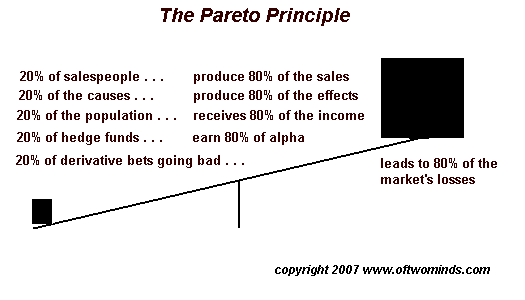

|
| weblog/wEssays archives | home | |
|
Hedge Funds and The Pareto Principle (February 19, 2007) Frequent contributor Harun I. invokes The Pareto Principle (the 80/20 rule) in an incisive analysis of last week's entry on hedge fund returns and alpha: What BGI (Barclays) does is what every technical trader attempts to do: develop a trading model with a statistical edge. The statistics sited are constant with the Pareto Principle (see below). I have found that what limits the trivial many investors and traders is an unwillingness to turn off the news, learn something about statistics, develop and rigorously test trading models and money management models and to understand the process of Group Rotation. 
In other words, "the vital few" (20%) influence effects more than the "trivial many" (80%). I must cop to not thinking through what "unregulated" means, given that who is allowed to invest in "risky" hedge funds is in fact highly regulated. This reminds me yet again not to take easy phrases for granted. Here is the Wikipedia link to The Pareto principle. This is a special case of the wider phenomenon of Pareto distributions. If the parameters in the Pareto distribution are suitably chosen, then one would have not only 80% of effects coming from 20% of causes, but also 80% of that top 80% of effects coming from 20% of that top 20% of causes, and so on (80% of 80% is 64%; 20% of 20% is 4%, so this implies a "64-4 law").If the "vital few" make most of the money in the hedge fund world--the Pareto distribution suggests 20% of the funds garner 80% of the returns, and only 4% have more influence on the markets than 64% of the "trivial many"--then we also discern the outlines of how a financial meltdown can occur with sudden, unexpected speed: the 4% of hedge funds who have over-extended leveraged bets on derivatives could bring down the entire derivatives market, even though it appears that their holdings are too limited to trigger such widespread havoc. For more on this subject and a wide array of other topics, please visit my weblog. copyright © 2007 Charles Hugh Smith. All rights reserved in all media. I would be honored if you linked this wEssay to your site, or printed a copy for your own use. |
||
| weblog/wEssays | home |